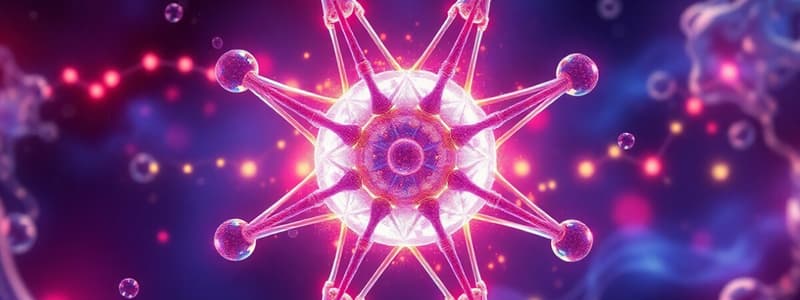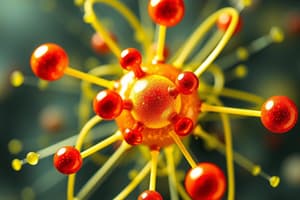Podcast
Questions and Answers
What is the primary reason an atom seeks to gain or lose electrons?
What is the primary reason an atom seeks to gain or lose electrons?
- To increase its mass
- To achieve a more stable outer energy level (correct)
- To create more subatomic particles
- To facilitate chemical reactions
What happens to an atom that loses one or more electrons?
What happens to an atom that loses one or more electrons?
- It gains an electric charge and becomes an ion (correct)
- It changes into a different element
- It remains neutral and stable
- It decreases in size
Which statement accurately describes the outer energy level of sodium (Na)?
Which statement accurately describes the outer energy level of sodium (Na)?
- It has one electron and can lose it (correct)
- It has multiple electrons and is unstable
- It is completely full with electrons
- It does not contain any electrons
What denotes a stable atom concerning its outer energy level?
What denotes a stable atom concerning its outer energy level?
What is formed as a result of an atom gaining or losing electrons?
What is formed as a result of an atom gaining or losing electrons?
Which energy level of an atom is typically filled first?
Which energy level of an atom is typically filled first?
In what state is an atom when all its energy levels are filled?
In what state is an atom when all its energy levels are filled?
Which of the following describes the concept of ionic bonding?
Which of the following describes the concept of ionic bonding?
What happens when opposite poles of a magnet are brought close together?
What happens when opposite poles of a magnet are brought close together?
What is a hydrogen bond?
What is a hydrogen bond?
Which two atoms make up a water molecule?
Which two atoms make up a water molecule?
How are hydrogen bonds between water molecules typically illustrated?
How are hydrogen bonds between water molecules typically illustrated?
What effect does the attraction between oppositely charged regions of polar molecules have?
What effect does the attraction between oppositely charged regions of polar molecules have?
Which statement is true about the nature of hydrogen bonds?
Which statement is true about the nature of hydrogen bonds?
When water molecules are near each other, what kind of interactions can occur?
When water molecules are near each other, what kind of interactions can occur?
What characterizes polar molecules like water?
What characterizes polar molecules like water?
What links water molecules through a specific type of bond?
What links water molecules through a specific type of bond?
What is the main characteristic of a homogeneous mixture?
What is the main characteristic of a homogeneous mixture?
In a solution, which part is considered the solute?
In a solution, which part is considered the solute?
Which of the following is NOT true about a mixture?
Which of the following is NOT true about a mixture?
What role does water play in the creation of a fruit-flavored drink?
What role does water play in the creation of a fruit-flavored drink?
How does a heterogeneous mixture differ from a homogeneous mixture?
How does a heterogeneous mixture differ from a homogeneous mixture?
Which statement is an example of a homogeneous mixture?
Which statement is an example of a homogeneous mixture?
What do you call the substance in which another substance is dissolved?
What do you call the substance in which another substance is dissolved?
What is a chemical reaction?
What is a chemical reaction?
Which of the following is an example of a biological process that involves chemical reactions?
Which of the following is an example of a biological process that involves chemical reactions?
Which part of a chemical reaction is responsible for initiating the process?
Which part of a chemical reaction is responsible for initiating the process?
What role do enzymes play in chemical reactions within organisms?
What role do enzymes play in chemical reactions within organisms?
What happens to energy during a chemical reaction?
What happens to energy during a chemical reaction?
Which statement best illustrates the importance of chemical reactions in daily life?
Which statement best illustrates the importance of chemical reactions in daily life?
Which of the following describes 'products' in a chemical reaction?
Which of the following describes 'products' in a chemical reaction?
Why is the understanding of energy changes in chemical reactions important?
Why is the understanding of energy changes in chemical reactions important?
What is the primary function of carbohydrates in organisms?
What is the primary function of carbohydrates in organisms?
What are the short chains of carbohydrates known as?
What are the short chains of carbohydrates known as?
Which statement about lipids is true?
Which statement about lipids is true?
What defines a disaccharide?
What defines a disaccharide?
Which of the following best describes the structure of carbohydrates?
Which of the following best describes the structure of carbohydrates?
What type of lipid is a triglyceride?
What type of lipid is a triglyceride?
Why are carbohydrates important for plant cells?
Why are carbohydrates important for plant cells?
Which of the following is NOT a function of proteins?
Which of the following is NOT a function of proteins?
Flashcards are hidden until you start studying
Study Notes
The Structure of an Oxygen Atom
- Oxygen's first energy level can hold up to 2 electrons.
- Oxygen's second energy level can hold up to 8 electrons.
Ionic Bonds
- Atoms are most stable when their outer energy levels are either empty or full.
- Atoms may give up or gain electrons to achieve stability.
- An atom that has gained or lost electrons becomes an ion, which carries an electric charge.
- Sodium (Na) has one electron in its outer energy level.
Polarity
- Magnets have opposite poles, which attract each other.
- Polar molecules have oppositely charged regions.
- Oppositely charged regions of polar molecules attract each other, resulting in hydrogen bonding.
- Water (H2O) is a polar molecule, and its molecules bond via hydrogen bonds.
Mixtures with Water
- A mixture is a combination of two or more substances where each substance retains its individual properties.
- A homogeneous mixture has the same composition throughout and is also called a solution.
- A solution contains a solvent (the substance in which another substance is dissolved) and a solute (the substance being dissolved).
- In a fruit-flavored drink, water acts as the solvent, and the drink powder is the solute.
Chemical Reactions
- Chemical reactions occur when atoms or groups of atoms in substances are reorganized into different substances.
Roles of Carbohydrates
- Carbohydrates consist of carbon, hydrogen, and oxygen with a ratio of 1:2:1 (CH2O).
- Monosaccharides are simple sugars, disaccharides are two linked monosaccharides, and polysaccharides are longer carbohydrate chains.
- Carbohydrates function as energy sources for organisms and provide structural support in various biological structures.
Lipids
- Lipids are molecules primarily composed of carbon and hydrogen.
- Lipids include fats, oils, and waxes.
- The primary function of lipids is energy storage.
- Triglycerides are lipids classified as fats when solid and oils when liquid.
- Waxes are lipids that coat plant leaves to prevent water loss
Proteins
- Proteins are involved in various cellular functions: transport, speeding up reactions, providing structural support, and acting as hormones.
Nucleic Acids
- Nucleic acids store and communicate genetic information.
Studying That Suits You
Use AI to generate personalized quizzes and flashcards to suit your learning preferences.




